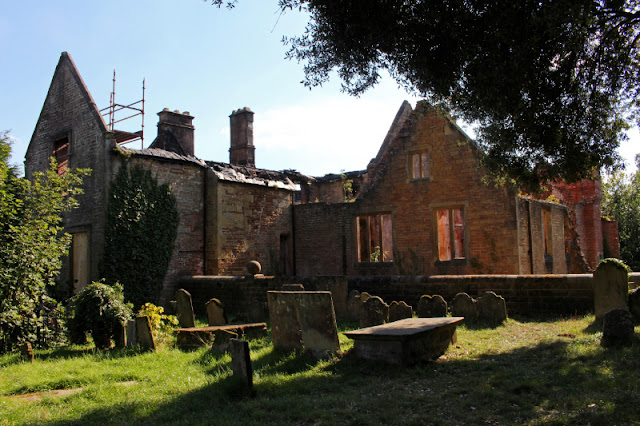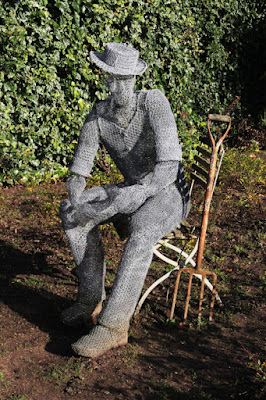Nottinghamshire is blessed with many fine country houses with the north of the county being known as the Dukeries. The county is recorded as having the highest number of Dukes in the country who built their grand houses in this area, to exploit the hunting of game in Sherwood Forest.
So in a series of posts recording these "Grand Houses" I first start with Newstead Abbey, Annesley Hall & Felley Abbey & as well as these three houses being within a few miles of one another they are connected by the lives of two families, the Byrons & the Chaworth-Musters. With these photos being taken over many years I have put the year under each one.
Newstead Abbey
1997
West Front.
Newstead Abbey is well known as the ancestral home of George Gordon Byron (1788 - 1824) better known as the 6th Lord Byron, poet & leading figure in the Romantic Movement.
Spending his childhood & early school days with his mother in Aberdeenshire he inherited Newstead Abbey & the Byron tittle at the age of 10 in 1798. It appears that he spent very little time at Newstead Abbey during his short life with him being educated at Harrow then going on the Grand Tour for two years, then seven years in Italy & then finally going to Greece to fight the Ottoman Empire in the Greek War of Independence. Due to his flamboyant lifestyle Byron was to enjoy the fruits of the money that he had inherited but at the same time ran up huge debits. He died in Greece at the age of 36 after contracting a fever in 1824. His body was returned to England & he is buried in St. Mary Magdalene Church, Hucknall.
1997
South Front.
I now go back to the time that he was at Harrow & in 1803 Byron met & fell in love with Mary Chaworth of Annesley Hall, my first connection for these three houses. Byron refused to return to Harrow because of this relationship with Mary & he did not take up his education again until 1804. Byron did not marry Mary but after many liaisons with both sexes he married Annabella Millbanke in January 1815 & their daughter Ada was born in December of that year. Ada under the guidance of her mother was to excel in science & mathematics & in 1833 she met Charles Babbage & they worked together in developing The Analytical Engine, an early predecessor to the modern computer.
1978
The Eagle Pond & gardens.
1997
The Abbey from the Garden Lake.
The Priory of St. Mary of Newstead, an Augustinian Priory was founded in 1170 by King Henry II as one his many penances he paid following the murder of Thomas Becket. Although it is now known as Newstead Abbey it was only ever a priory. The 13th century saw many additional buildings being added & at the time of the Dissolution 13 monks lived at the priory.
Henry VIII granted Newstead to Sir John Byron of Colwick Hall, Nottinghamshire in 1540. He was followed by his son John at Newstead who added many new buildings to the ruined 13th century ecclesiastical buildings which had been made inhabitable during the Dissolution.
I now fast forward to the 6th Lord Byron, George Gordon the poet. He inherited Newstead at the age of 10 with the building being in a poor state of the repair the estate was leased to Henry Edward Yelverton, 19th Baron Grey de Ruthyn for five years at £50 per year. After the lease in 1808 Byron moved into Newstead making expensive renovations mainly to the decor & to make the buildings water tight.
Byron is well known for his love of his dog, Boatswain who died in 1808 & is buried within the Abbey grounds with a large monument inscribed with a poem by Byron dedicated to his best friend. Byron wanted to be buried with Boatswain but he was finally laid to rest in the family vault in St. Mary's Church, Hucknall.
Byron lived on & off at Newstead & in 1818 after a few failed attempts to sell the Abbey & while he was in Italy, the estate was sold to Thomas Wildman who had been at Harrow School with Byron, for £94,500 which eased Byron's financial circumstances.
Wildman spent large sums of money in renovating the Abbey & after two more owners Newstead Abbey was presented to Nottingham City Corporation in 1931. Today it is a publicly owned museum run by Nottingham City Council, housing a collection of Byron's artefacts.
1997
Garden Lake & part of the Japanese gardens.
1997
West view of the Abbey from the far side of the upper lake.
The following photos were taken over two days in November 2015 & this first one is of the East Front & Eagle Pond.
East Front & walled knot garden.
Boatswain monument & Byrons poem to his beloved dog.
An oil painting of Boatswain which hangs in the Abbey.
Abbey ruins from the east.
Eagle Pond. This is so named after the eagle lectern that was found in the pond which was believed to be put their by the monks at the time of Disillusion & is now in Southwell Minster.
" That garden won't get dug sat there ! "
There are several excellent life size gardeners at work & rest made of chicken wire in the walled gardens.
Walled Gardens.
"Put your back into it lad & get it turned over !"
Autumn shades.
"Nice & even lad !"
South Front.
On the two days that I had recently visited Newstead Abbey the Abbey was not open, but I saw an advertisement board telling you that the Abbey would be open for a Christmas Fayre at the beginning of December. So I took this opportunity to reacquaint myself with the inside of the house as it had been many many years since my last tour of the house. The Abbey rooms were all dressed with Christmas decorations & a young man, dressed in period clothing was belting out "ye olde Christmas Carols" through a very loud amplifier which could be heard all through the house. At the end of the tour you come to the cloisters & this is where local crafts people had there stalls. So it was a good few hours out with a gentle stroll down to the Abbey on a mild December morning & then being serenaded through out the tour of the house with this young man's excellent singing. What more could you ask for, for an entrance fee of £5 including car parking !

After finding that you were allowed to take photos inside the house, I photograph an oil painting of the 6th Lord Byron which hangs in the main hall & then his study which was one of the first rooms he made habitable after he had took over the house. Byron had a strong interest in boxing & the screen had come to Newstead from his London apartments after his death.



























































